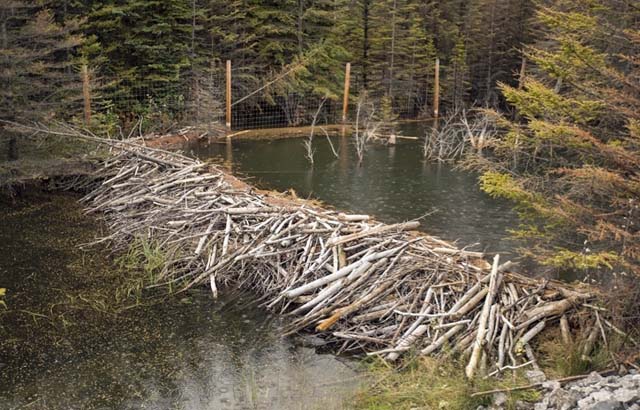
Banff Alberta - Parks Canada has been working to save a well-known beaver dam just off the Legacy Trail in Banff National Park that almost
completely dried up.
Water levels were reduced when Canadian Pacific Railway raised safety concerns that a mud beaver dam was blocking a culvert under the train tracks, however,
flows were so low that the prominent main dam right beside the Legacy Trail almost disappeared, inadvertently.
At about the same time as water flows were knocked back into that system, two beavers were found dead in the area after being run over by vehicles on the
Trans-Canada Highway.
Bill Hunt, resource conservation manager for Banff National Park, said Parks Canada has been working closely with TransAlta to bring flows back up in the
system to keep the main beaver dam by the Legacy Trail.
"I went by and it's back up to the base of the beaver lodge and most of the water seems to be staying within the logged dam," Hunt
said.
"The beautiful dam, made primarily of wood and mud immediately adjacent to the Legacy Trail, will not be affected by CP's work. We just hope we haven't
displaced those beavers."
Canadian Pacific Railway wants to remove a mud dam on the south side of the wildlife exclusion fence which is blocking a culvert beneath the railway line and
causing concerns for track safety.
At the same time CP requested to do the work, Parks Canada was in the midst of dealing with the threat of whirling disease, which had been found in fish in
Banff's Johnson Lake.
It's a disease that's been known to decimate fish populations.
As a precaution, the federal agency asked CP to hold off on the work and keep the dam in place until they were able to determine if whirling disease was also
in the Bow River.
It was later confirmed to be in fish in the Bow River.
In the interim, Parks Canada worked with TransAlta to knock back flows into that system, which in turn led to two dams drying up and the main pond by the
Legacy Trail running dangerously low.
"We had TransAlta lower water levels to try to address the safety concern that CP brought to us and that bought us some interim time while we waited on
the lab results back on whirling disease," Hunt said.
"Now that we know whirling disease occurs on both sides, we're not as concerned about removing the dam, so CP is proceeding with removal of the mud dam
that's blocking the culvert. They've been very cooperative."
The water levels have since been brought up to 50 percent.
"I think we've found the sweet spot," said Hunt.
"Once CP is able to remove the dam, then we will work with TransAlta to restore full flows to that."
CP officials say the company regularly removes beaver dams across the country in order to ensure the safety of its tracks.
"Unequal accumulations of water, or a rapid release of water, can lead to track instability or washouts," said Salem Woodrow, a company
spokesperson.
"While working closely with Parks Canada and the Canadian Food Inspection Agency, CP engineering personnel were closely monitoring the tracks during the
water level reduction process."
Beavers are known for their unprecedented feats of ecological engineering, building dams, ponds, and wetlands that can flood and damage human infrastructure,
and are persecuted by humans as a result.
They are also a keystone species, creating ponds with consistently higher waterfowl diversity while providing critical habitat for amphibians.
They also create habitat that provides flood mitigation and resilience to extreme drought.
Parks Canada asks if people see beavers in the area by the Legacy Trail beaver dam to call 403-762-1470.
Cathy Ellis.



